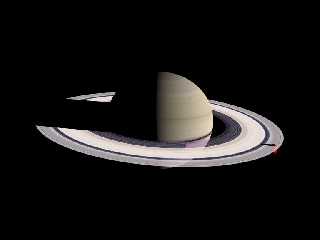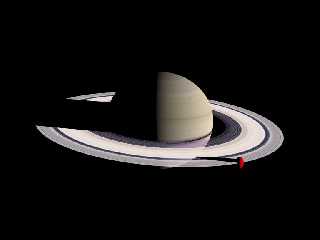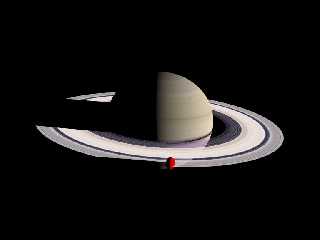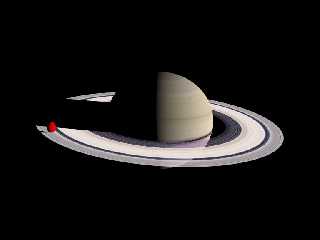|
 |
High!
After Reactor led me out of the "media trap" while trying to get
believable Saturnian rings, the next problem occurred: I'm just not able
to make a moon (in this test it's Pan, the innermost one running in the
Encke ring gap at about 135,000 kms from the planet's center) orbiting
exactly in Saturn's equatorial plane!
Saturn is tilted using my "SetAxis" macro according to the equatorial
coordinates of its axis (gleaned from Wikipedia):
#macro SetAxis(dec, ras)
rotate <23.439281-(90-dec), 0, 0>
rotate <0, 90-ras, 0>
#end
which is invoked with the parameters 83.537 (declination) and 40.589
(right ascension, in degrees).
After I programmed a small test scene (code attached below) to probe
different inclinations and ascending node angles for orbits, I assumed
the transformation of these two values into my solar system model to be:
#declare Pos_Pan = Pos_Saturn +
bodies[2][0]*<cos(radians(23.439281-(90-bodies[1][10])))*sin(radians(clock)),
sin(radians(23.439281-(90-bodies[1][10])))*sin(radians(clock-(90+bodies[1][11]))),
cos(radians(23.439281-(90-bodies[1][10])))*cos(radians(clock))>;
...but it didn't work - as you can see in the five images attached (Pan
colored red and heavily exaggerated in size for better visibility, at
orbit doesn't match Saturn's equatorial, i. e. ring plane!
Regardless what combinations of signs and angle values I tried, I never
got Pan orbiting in the ring plane...
Here is the small test scene:
// beginning of code
light_source
{
<-5000, 0, 0>
color rgb 1
}
#declare moon_dist = 5;
#declare moon_incl = 45;
#declare asc_node = 60;
sphere // planet
{
0, 1
pigment { rgb <1, 0, 0> }
}
sphere // moon
{
0, 1
pigment { rgb <1, 1, 0> }
scale 0.2
translate moon_dist*<cos(radians(moon_incl))*sin(radians(clock)),
sin(radians(moon_incl))*sin(radians(clock-asc_node)),
cos(radians(moon_incl))*cos(radians(clock))>
}
camera
{
orthographic
location <-20, 0, 0>
look_at 0
angle 50
}
// end of code
...and here the Saturn scene:
// beginning of code
// INCLUDES
#include "functions.inc"
// VARIABLES
#declare sc=13347; // 13347; // 1 POV unit = 13347 kilometres
global_settings
{
max_trace_level 20
assumed_gamma 1.5
}
// FINISHES
#declare F_Standard_Planetary_Surface =
finish
{
ambient 0.0001
diffuse 1
brilliance 0.8
}
#declare F_Saturn_Rings =
finish
{
ambient 0.0001
diffuse 1
brilliance 0.05
}
#declare bodies = array [3][12]
{
{ 0, 696000, -1, -1, 7.25, 0,
0, 0, 0, 0.000009, 63.87, 286.125 },
// 0 - Sun
{ 1433449370, 60268, 54364, 60268, 26.73, 2.484,
0.055723219, 336.013862,113.642811,-1, 83.537, 40.589 } //
1 - Saturn
{ 133584, 17.5, 17.5, 11.5, 0, 0.0001,
0.0000144, -1, -1, -1, -1, -1 } //
2 - Pan (Saturn XVIII)
}
#declare Pos_Saturn = bodies[1][0]*<sin(radians(157.4)), 0,
cos(radians(157.4))>;
#declare Pos_Pan = Pos_Saturn +
bodies[2][0]*<cos(radians(23.439281-(90-bodies[1][10])))*sin(radians(clock)),
sin(radians(23.439281-(90-bodies[1][10])))*sin(radians(clock-(90+bodies[1][11]))),
cos(radians(23.439281-(90-bodies[1][10])))*cos(radians(clock))>;
#declare cam = 0; // camera mode
#switch (cam)
#case (0) // centered on Saturn, view of lit ring ride
#declare camPos = Pos_Saturn + 500000 * <sin(radians(64)), 0,
cos(radians(64))>;
#declare camLook = Pos_Saturn;
#declare camAng = 40;
#break
#case (1) // centered on Saturn, view of unlit ring side
#declare camPos = Pos_Saturn + 500000 * <sin(radians(244)), 0,
cos(radians(244))>;
#declare camLook = Pos_Saturn;
#declare camAng = 40;
#break
#end
#macro SetAxis(dec, ras)
rotate <23.439281-(90-dec), 0, 0>
rotate <0, 90-ras, 0>
#end
light_source // Sun
{
0
color rgb 1
looks_like
{
sphere
{
0, 1
texture
{
pigment { color rgb <1, 1, 0.85> }
finish { ambient 1 diffuse 0 }
}
scale bodies[0][1]/sc
SetAxis(bodies[0][10], bodies[0][11])
}
}
}
#declare Saturn_Rings_Colors =
pigment
{
image_map
{
png "solarsys/sat_ring_color_bjoernjonsson.png"
}
}
#declare Saturn_Rings_Transparency =
pigment
{
image_map
{
png "solarsys/transparency_bjoernjonsson.png"
}
}
union
{
sphere // Saturn
{
0, 1
texture
{
pigment
{
image_map
{
jpeg "solarsys/saturn_bjoernjonsson.jpg"
map_type 1
interpolate 2
}
}
finish { F_Standard_Planetary_Surface }
}
scale <bodies[1][1], bodies[1][2], bodies[1][3]>/sc
}
difference // rings
{
cylinder
{
<0, -0.011, 0>/sc, <0, 0.01, 0>/sc, 140390/sc
}
cylinder
{
<0, -0.012, 0>/sc, <0, 0.011, 0>/sc, 74510/sc
}
double_illuminate
texture
{
pigment
{
cylindrical
color_map // preliminary low-res version
{
#declare a=0;
#while (a<255)
#declare c=eval_pigment(Saturn_Rings_Colors,
<509/510-a/255, 0.5, 0>);
#declare f=eval_pigment(Saturn_Rings_Transparency,
<509/510-a/255, 0.5, 0>);
[a*(((140390-74510)/140390)/255) rgb c filter f.gray ]
#declare a=a+1;
#end
}
scale 140390/sc
}
finish { F_Saturn_Rings }
}
}
SetAxis(bodies[1][10], bodies[1][11])
translate Pos_Saturn/sc
}
sphere
{
0, 1
texture
{
pigment { color rgb <1, 0, 0> }
finish { F_Standard_Planetary_Surface }
}
scale <bodies[2][1], bodies[2][2], bodies[2][3]>/sc*300
translate Pos_Pan/sc
}
camera
{
location camPos/sc
look_at camLook/sc
angle camAng
}
// end of code
I really wonder whether I'm in fact intellectually handicapped - most of
you, I assume, throw out such scenes even when half asleep, and they are
flawless! Could it be in fact better for me (and this group) to give up
POV-Ray entirely and turn to something more appropriate for my moronic
little brain, such as munching donuts or collecting die-cast model cars...?
Post a reply to this message
Attachments:
Download '2009-12-03 pan test, take 1.jpg' (21 KB)
Download '2009-12-03 pan test, take 2.jpg' (22 KB)
Download '2009-12-03 pan test, take 3.jpg' (21 KB)
Download '2009-12-03 pan test, take 4.jpg' (21 KB)
Download '2009-12-03 pan test, take 5.jpg' (21 KB)
Preview of image '2009-12-03 pan test, take 1.jpg'

Preview of image '2009-12-03 pan test, take 2.jpg'

Preview of image '2009-12-03 pan test, take 3.jpg'

Preview of image '2009-12-03 pan test, take 4.jpg'

Preview of image '2009-12-03 pan test, take 5.jpg'

|
 |




![]()